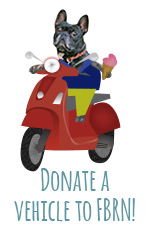Things You Should Know to Keep Your Frenchie Safe
1. Out of the deaths in cargo holds the airlines reported over the last 5 years, almost half were Brachycephalic, or smush-faced, breeds. Most airlines won't carry dogs when temps are high. If you are traveling and you must take your Frenchie, make sure your frog rides in cabin with you. Read about it here.
|
|
|
|
|
|
2. People may doubt this is true, but don't give your dog grapes or raisins. Dogs can have a reaction to as few as 7 or 8 grapes that will cause kidney damage and, possibly, death. If you have kids, be sure to tell them not to share, and don't leave grapes out. Onions can also be deadly to your dog.
3. Macadamia nuts are a little-known addition to the 'do not feed' list.
4. Though by now most people are aware that chocolate, especially dark chocolate, can be deadly to your dogs, you should also know that the mulch made from cocoa should probably be avoided. Though the risk depends on the brand you buy and the size of the dog and whether the dog is likely to eat mulch, there are so many other kinds of mulch that it seems not worth the risk.
5. If you live in the southernmost areas of the US, you have particular dangers to be aware of. The bufo toad is one of them. The bufo toad, or cane toad, was yet another brilliant idea gone wrong in the annals of foreign animal introduction. Used to control bugs in sugar cane fields, the bufo toad quickly moved off the fields and into the suburbs. Some of our volunteers have had dogs that enjoy catching toads and they must be vigilant about not allowing their dogs to catch bufo toads, which can poison and kill or harm their dogs very quickly. See this link for more information on how to give first aid to a dog who catches a bufo toad. People who live in more northern states have ordinary toads who may also give off a substance that causes foaming at the dog's mouth, but won't harm them. One of our volunteers has to regularly remove toads from her dog, because their unpleasant taste does not deter the dog from catching them.
6. The sago plant is also deadly to dogs, and is a commonly used landscaping plant, particularly in the south. Are you thinking of landscaping? The ASPCA is compiling a list of toxic plants. The ASPCA also has an Animal Poison Control Center hotline at (888) 426-4435. There is a charge to call.
7. Tea tree oil, though touted for its anti-bacterial, flea-fighting and healing qualities, may cause neurological damage to your Frenchie and might well kill your cat. One of volunteers used undiluted tea-tree oil on her Frenchie and almost lost him. Though we applaud the use of many herbal treatments, and the danger of tea-tree oil diminishes if the oil is diluted, our advice is to use something else.
8. Your toothpaste could kill your dog. Pretty silly lead-in, but it's true. Many dogs love mint, and some of our dogs will go to great lengths to get to the toothpaste tube or into our handbags or pockets or even up on the counters to get at the source of that great minty smell! Unfortunately, many mints, chewing gums and toothpastes contain an artificial sweetener called xylitol, and eatingxylitol can be deadly for dogs. We recommend extreme vigilance with products that contain xylitol. Consider going for a sugared vs. sugar-free version of mints, chewing gum and other candies. And never use a people toothpaste to brush your dog's teeth!
9. You can buy a seat belt for your dog. So many of us just load our dogs into the car without giving them any restraint or harness at all. It's nice to have them on the front seat beside us. But we know better, and in a crash a dog can become a missile and cause injury, or he can escape from the car and be lost. There are a great range of car seats, restraints and screens for your car. Remember that if a baby can get injured or killed by an airbag, your Frenchie could, too. (Other things to have in the car: cool coat, water, ice and working cell phone in case your engine overheats or your a/c up and quits.)
10. If you haven't seen one before, a Frenchie in a lifevest looks pretty silly. But most bulldogs are bricks when they hit the water. If you are going to the river, lake, or ocean, please put your dog in a lifevest. Even if you are going to the backyard to hang out by the pool. Put a vest on your dog. It only takes a minute for you to go in to the house for a beverage and take a phone call, and your Frenchie could be lost. Every summer we hear of at least two of our adopted dogs who've drowned. It breaks our hearts.
11. Raw Salmon. Even if you are a pretty well educated raw food feeder, you may not have heard of this. The problem is a critter that rides along on a parasite that the salmon picks up from a freshwater snail. If you live in the Pacific Northwest and come across salmon innards a lucky fisherman left behind, or you want to offer a bit of raw salmon to your dog on a fishing trip, don't do it. Cooked salmon is fine. Another reason not to let your dog roam offlead.
12. Mushrooms. Maybe not strange, but it's true that the same Death Cap mushroom that can kill you can kill your dog. Recently, most deaths from Death Cap mushrooms have been in northern California and Oregon. There are other mushrooms that will just make your Frenchie sick, but if you are out walking where there are likely to be toadstools or mushrooms, keep your dog on a leash. If he eats something before you can stop him, at least you can take one home with you to show your vet.
|
|
13. Dental floss. I had a dog who needed surgery because she got a box of mint-flavored dental floss and ate the the whole wheel of floss except for the several feet that were hanging out of her mouth. Floss can cut through your dog's intestines and dump all the contents of their intestines into the abdominal cavity. Dispose of your dental floss carefully'now I flush mine'and maybe choose a floss that is not flavored.
14. Dog doors. The AKC reports that dog thefts are on the rise. Dog doors may be one way thieves are finding it easy to get at dogs. Even people with high brick walls you wouldn't think thieves could see over are coming home to find one or more of their Frenchies are gone. Dog doors can be a great convenience in terms of housetraining, but at least judging by the stolen dog reports we've gotten, if you live in California or Texas, beware. Dog thieves are looking to take your dog.
Sure, you may never run into a cane toad, and maybe you wouldn't know a sago plant if you fell over one, but we wanted you to know about this stuff. Until someone told us or we found out the hard way, we didn't know, either.
Why Microchip?
Dogs get loose. They just do. Whether it prances out through an unsecured gate, or it slips out between your feet, or the wind blows an unlatched door open and he follows his nose into the breeze--dogs get loose. You are fortunate indeed if you've never had to go looking for your dog, your heart in your throat, hoping to find him.
Dogs get stolen. French bulldogs are being stolen more and more often, particularly in cities. They are not held for ransom, but are either kept or sold on Craigslist or otherwise disposed of for money.
Once you buy the chip, have it inserted by your vet and then don't forget to register the chip number. Many shelters find strays with chips that have never been registered.
Having a chip on your dog can mean getting your dog back if it's stolen or lost. That alone is worth the cost and small amount of trouble to register your dog with the company.
Food Allergies and Ear Infections
Does your dog lick her paws? Do his ears or paws smell yeasty—a little like Fritos corn chips? Does he scratch himself, shake or cock his head, or rub his bottom on the floor? If so, your hairy pal may be suffering from allergies and the skin irritation and infections that can come with them.
One of the most common culprits is allergies to food, often to the proteins in grains, but many dogs are also sensitive or allergic to familiar protein sources and their by-products, like chicken, beef, and turkey. Another allergen found in dried food sounds especially nasty and is virtually everywhere that dried food—breakfast cereal, pasta, flour—is stored: “storage mites.” These microscopic animals love kibble, but they cause many dogs to suffer severe and/or chronic allergic reactions.
So many of the dogs we get into rescue have had multiple untreated ear infections that come out of allergies to food as well as other things, and the results can be shocking to see. Take Brenda. Though we probably get a half dozen dogs a year who need to have total ear canal ablation (TECA), whether on one side or both, the cause is always frequent, untreated ear infections. In Brenda’s case, her chronic, untreated ear infections caused terrible scarring which blocked in the infections, leaving no way for the infected material to exit the ear canal. Can you imagine the pain? And someone had viciously mangled the job of cutting off her beautiful Frenchie ears, God alone knows why, and the outer ears were also infected when she came to us. By the time the surgeries were done, Brenda’s inner ears had been removed, and her outer ears were also gone, leaving her deaf and looking bizarrely mutilated. Though she has lost her hearing and her pretty ears, she is pain free for the first time in a long while.
Brenda Before |
Brenda After |
Though Brenda’s case is a horrific example of owner cruelty and neglect, and most owners are far more observant and responsive, it is a good idea to keep an eye on your dog’s ears and do occasional cleanings to check for things like ear mites and yeast. Your dog may suffer seasonal reactions unrelated to food, so at least once a month, you should be taking a look and cleaning the ears.
If your dog does suffer from repeated infections or yeast, you may want to ask the vet to talk to you about an elimination diet. Some of our foster dogs are allergic to virtually all the meat and meat products found even in expensive kibbles, so we must look to proteins like goat. Some dogs can’t tolerate carbohydrates or sugars—even in vegetables—and you can help control yeast infections by controlling the amount and type of carbohydrate in their diets.
 Ask your vet how often you should be cleaning your dog’s ears and ask her to show you how to do it with the product she recommends. If you decide to try feeding your dog home-cooked or raw meals, be sure to research the nutritional needs of your dog, according to weight and activity level. If you feed kibble, one way to control storage mites is to buy smaller quantities and keep the bag in the freezer.
Ask your vet how often you should be cleaning your dog’s ears and ask her to show you how to do it with the product she recommends. If you decide to try feeding your dog home-cooked or raw meals, be sure to research the nutritional needs of your dog, according to weight and activity level. If you feed kibble, one way to control storage mites is to buy smaller quantities and keep the bag in the freezer.
Repeated ear infections are a sign that your dog is trying to deal with some kind of sensitivity and there is a problem with her immune response. Something is wrong.
Get help from your vet.
Spine-injured, Disabled, and Cart dogs
If you’ve followed FBRN for a while, you will have noticed that the number of dogs on our roster who have spinal injuries has increased. The reasons for that increase don’t have to be spelled out (let’s just say it’s a really good idea to research your breeder, learn lots about Frenchies before you buy one, and be sure to get doggy health insurance if you don’t have $12,000 on hand or available on your credit card. Assume you will need a doggy MRI to the tune of $3,000 -$5,000 at some point in your Frenchie’s life. You should also have a serious internal discussion about whether you can face caring for a disabled frogdog in the event your dog is injured, or develops IVDD and surgery is not successful).
 Our spine-injured dogs, some of which use carts, so we call them "cart dogs", are happy as clams. They are not in pain. Most of them only use their carts when it’s time for exercise. Inside the house, spine-injured dogs' mobility ranges from wobbly walkers to back-end draggers, but they get around. Likewise, there is a great variation in bowel and bladder control. Some of our dogs have good bladder control but no bowel control, some have bowel and bladder control, and some have neither. You will see that some of our spine-injured dogs wear diapers or belly bands indoors. For dogs without bladder control, the owner gives the dog a helping hand by expressing the bladder. There are videos on Youtube illustrating the method, but your vet will show you how and can correct your form as you learn.
Our spine-injured dogs, some of which use carts, so we call them "cart dogs", are happy as clams. They are not in pain. Most of them only use their carts when it’s time for exercise. Inside the house, spine-injured dogs' mobility ranges from wobbly walkers to back-end draggers, but they get around. Likewise, there is a great variation in bowel and bladder control. Some of our dogs have good bladder control but no bowel control, some have bowel and bladder control, and some have neither. You will see that some of our spine-injured dogs wear diapers or belly bands indoors. For dogs without bladder control, the owner gives the dog a helping hand by expressing the bladder. There are videos on Youtube illustrating the method, but your vet will show you how and can correct your form as you learn.
Over the past few years, we’ve seen a true cultural shift in dog-owners’ attitudes toward disabled dogs. Where once dog owners saw disabled dogs as unhappy and suffering, and thought the kindest thing to do was euthanize a disabled pet, we’ve seen a sea-change in both owners and potential adopters. Where once a cart dog spent many, many months on the Available page, our cart dogs now spend far less time waiting for their forever families to find them.
Here is a letter from one of our volunteers who is living with a cart dog:
“If you are considering adopting a cart dog, congratulations and thank you! In the beginning it might be an adjustment, but routines are everything, and now that I have a routine, it's almost like my pup isn't even in a cart. Thankfully, small Frenchies are pretty portable, so I often carry him wherever he can't go in his cart. And he can go A LOT of places in his cart. We live on 5 acres of desert, and he can go most everywhere.
“Dozer is a 7-year-old male Frenchie who went down in his back end 48 hours after sustaining a fall off the bed onto padded carpet one year ago. I have had him since he was 4 months old, so I had already mentally accepted the possibility of his life in a cart even before I knew surgery and other therapies hadn't worked. Never once did I contemplate euthanasia as an option. I feel absolute pride when I take him out in his cart and people see how well he does. Many express feelings of sympathy, but I tell them he's still the same pup, only faster. He still loves to play and has the same spunky personality. Dogs live in 'the now.'
“He has only been in his cart for a year, so I haven't noticed many changes in our routine from the first day to now. It has gotten a little faster/easier because my bladder expressing technique has improved. He has gained strength; he is much more muscular through his chest and forelegs due to the cart, so I massage those muscles frequently to keep them loose and injury free.
“Finding someone who can express your dog’s bladder while you’re on vacation may be harder than finding an ordinary boarding situation or leaving your dog with family. Thankfully, we have someone we know and trust, but this is a possible major expense ($40-80/day) to keep in mind. But that is really the only majordifference—in the past, my parents watched our dogs at no charge.
“In terms of his health, I do have to watch for sores from his dragging his body across our tiled floors (no carpet is a MUST with bowel incontinent dogs) but there are "drag bags"—sacks that fit over the lower body--you can easily make or buy to help prevent friction. I would also say providing proper nutrition is vital to ensure muscle health. A couple of nice, thick beds around the house help prevent pressure on his joints when he is lying down.
“I have been thinking very hard about what I would specifically tell people who want to adopt a cart dog. Since the changes that came with a cart dog have become second nature this past year, I don't find it an inconvenience at all in my lifestyle or routine. Perhaps the biggest change is expressing Dozer’s bladder. My veterinary neuro surgeon only has me expressing his bladder twice a day (which is very convenient for my schedule), and I have not had any issues with urinary tract infections. UTI’s are common and can be more serious in paralyzed pups, so learning the signs of a UTI will be an important new skill if you adopt a cart dog.
“I do consider myself a very dedicated, committed, and conscientious dog lover, and though I work full time, I can take time for myself—caring for Dozer is not a job that consumes my whole life. While expense may be an issue (as with any dog’s physical affliction, e.g., allergies), I think commitment and patience are especially important qualities to have with a cart pup. More frequent outings for bowel evacuation may be necessary, and there may be indoor accidents, depending on your dog’s injury and condition. My husband wanted me to add: “Be ready to buy lots of baby wipes and stock them in various areas of your house and car for easy retrieval. Preparedness is key for those times they are needed.”
Dozer’s owners experience is unique, as is every dog owner’s time with any dog. If you are curious about a cart dog, read the bio carefully, address the concerns in the bio, apply, and see what happens. You’ll have lots of opportunities to talk with the foster parent about life with a cart dog during the interview and adoption process.
We have recently taken in 3 dogs whose spine injuries vary from serious to relatively minor. If you have seen a Frenchie, a Doxie, a Corgi—all dogs with a reputation for spine injuries-- or any other dog rolling along at a happy clip in your nearby park, you can see that there’s no reason to pity them or make a sad face as they go by. Dogs enjoy the moment, and cart dogs may have a great lesson to teach us about accepting what is and rolling with what comes.
Holiday Safety Tips

1. If you live in cold weather areas, your Frenchie needs a coat or AND sweater to keep him warm when he goes outside. If he doesn't want to walk or cries during your walks, you may think about adding boots—your Frenchie's feet may be too cold, and it takes time to toughen up those pawpads for winter walking.
2. Do not leave your dog outside alone in sub-freezing temps for any length of time. This includes the car! Leave your Frenchie at home while you do your gift shopping and errands. He'll be happier in the warm indoors, and you'll be more relaxed knowing he's safe at home.
3. If you walk your dog in an area that uses road salt to keep the streets clear of ice, be sure to wash your dog's feet when you get home (a 9x11 jelly roll or cake pan with a quarter inch of warm, lightly soapy water is all you need. Have your dog walk through the water and dry his paws). Or use a very wet cloth and wash his feet. FBRN's holiday shopping mall is offering a product to protect your frog's feet: Pawz Guard.
4. Do not, under any circumstances, allow your dog to get near the anti-freeze! Anti-freeze has a sweet taste and is appealing to pets, but it is deadly, even in very small amounts. We recommend you let the people at the oil change shop put in the anti-freeze: don't even keep it at your home.
5. If you are entertaining this holiday season, keep your pets away from the treats, especially chocolate- and alcohol-laden goodies. Never give a dog cooked bones, and limit table scraps. Too much fat can cause pancreatitis.
6. Winter plants like mistletoe and holly can cause intestinal distress and other problems.
7. Don't decorate with tinsel strands on the tree, unless you have a couple of thousand dollars for a linear foreign body surgery to save your dog's life. Be sure to keep breakable ornaments on the higher branches. Don't leave anything edible in the tree or under it, even if it's wrapped. And don't leave your dog unattended with the tree--your idea of what's edible and his idea of what's edible may be two different things!

 Just a reminder about the perils that the upcoming holidays pose to Frenchies. A dog tragedy will spoil your fun for sure, and many can be avoided if you exercise some caution.
Just a reminder about the perils that the upcoming holidays pose to Frenchies. A dog tragedy will spoil your fun for sure, and many can be avoided if you exercise some caution.
More obvious dangers are turkey bones or any poultry bones, which can splinter and injure the dog's mouth, throat, or gastrointestinal tract, or cause an obstruction. Less obvious is turkey skin, or anything fatty. Excess fat in the diet is the #1 cause of pancreatitis in dogs, and that can be fatal. So ignore those pleading looks on Thanksgiving and give your dog a dog treat instead. And of course, chocolate (way too available at holiday time) is a big no-no.
 Another overlooked danger at the holidays is tinsel, ribbon, yarn, string... any "linear foreign body." If a dog (or cat, as they tend to go for those more than dogs do) eats a string or anything similar (dental floss is a killer), it will stretch out in the intestinal tract and if one end of it becomes anchored somewhere, movements of the gut will cause it to "saw" through the intestinal wall. The resulting spillage of gut contents into the body cavity can be rapidly fatal.
Another overlooked danger at the holidays is tinsel, ribbon, yarn, string... any "linear foreign body." If a dog (or cat, as they tend to go for those more than dogs do) eats a string or anything similar (dental floss is a killer), it will stretch out in the intestinal tract and if one end of it becomes anchored somewhere, movements of the gut will cause it to "saw" through the intestinal wall. The resulting spillage of gut contents into the body cavity can be rapidly fatal.
 Styrofoam packing peanuts or a chunk of styrofoam cup or plate, especially something that's had something tasty in it, can get stuck in the airway and kill a Frenchie. If it gets down into the gut, it can cause a blockage.
Styrofoam packing peanuts or a chunk of styrofoam cup or plate, especially something that's had something tasty in it, can get stuck in the airway and kill a Frenchie. If it gets down into the gut, it can cause a blockage.
Plants like mistletoe, amaryllis, holly are very toxic, but poinsettia (while it can irritate a dog's mouth and stomach) is not as toxic as it's been described.
The little disc batteries that are used in watches, hearing aids, and some blinking jewelry and games are irresistable to dogs, but are potentially deadly. If swallowed it can very quickly start leaking caustic materials that will burn the stomach or gut. Get to the vet or emergency clinic immediately.
Just be extra vigilant, and you can keep your Frenchie safe until the new year. Jan Grebe












